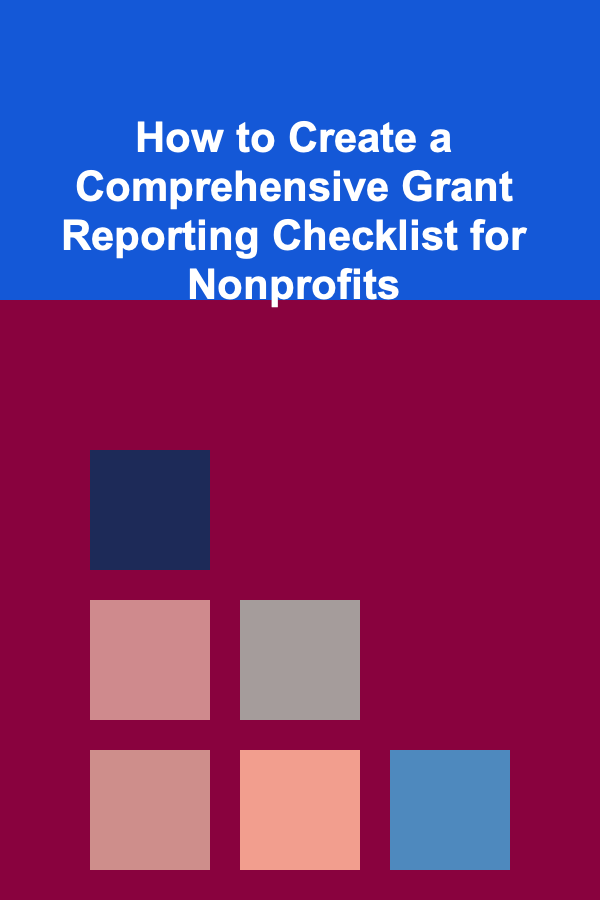
How to Create a Comprehensive Grant Reporting Checklist for Nonprofits
ebook include PDF & Audio bundle (Micro Guide)
$12.99$6.99
Limited Time Offer! Order within the next:

Grant reporting is a vital aspect of nonprofit operations, ensuring that organizations remain accountable, transparent, and in good standing with their funders. Whether you're a small nonprofit or a larger organization, clear and consistent grant reporting helps build trust and ensures you're meeting both donor expectations and legal requirements. To make the process more manageable, creating a comprehensive grant reporting checklist can provide a roadmap for keeping track of critical information, deadlines, and documentation.
In this actionable guide, we'll walk through the steps involved in creating an effective grant reporting checklist for your nonprofit. By following these steps, you can ensure you meet reporting requirements, avoid errors, and streamline the process to save time and resources.
Step 1: Understand the Grant Reporting Requirements
Before you start creating your checklist, the first step is to thoroughly understand the specific reporting requirements for each grant you've received. Different funders may have different expectations regarding the type of information they require and how they want it reported. Some grants may have very specific reporting templates or formats, while others may give you more flexibility.
Key Points to Consider:
-
Grant Agreement Review: When you first receive a grant, carefully review the grant agreement or contract. Pay attention to any clauses that outline specific reporting requirements, such as:
- Reporting deadlines (quarterly, semi-annual, or annual)
- Required financial reports (e.g., budget updates or balance sheets)
- Performance metrics or specific deliverables that need to be tracked
- Whether a narrative report is required
- Guidelines for how to measure and report outcomes
- Acknowledgment of the grant in communications and publicity materials
-
Funder Communication: If anything is unclear, reach out to the funder to clarify expectations. This can help avoid misunderstandings and ensure you're on the same page.
-
Types of Reports: Some common types of reports nonprofits may need to submit to funders include:
- Financial Reports: Detailing how the grant funds were spent, typically requiring receipts, budget updates, and balance sheets.
- Narrative Reports: Explaining the progress of the funded project or program, challenges encountered, outcomes, and lessons learned.
- Progress Reports: Shorter, interim reports that track key milestones or updates on the project.
Step 2: Organize Key Grant Information
After gathering the necessary information, the next step is to organize it for easier access and tracking. Having a dedicated system for managing this information is essential for both efficiency and accuracy. Consider creating a centralized file or digital database that includes all relevant details about each grant.
What to Include in Your Grant Information File:
- Grant Details: Record the funder's name, the grant amount, the project or program it's funding, and the specific reporting requirements.
- Timeline: Include reporting deadlines, project milestones, and any other important dates. A simple spreadsheet or calendar can help you keep track of key reporting dates for each grant.
- Contacts: Keep a record of all key contacts at the funding organization, including the grant manager, reporting coordinator, and any other relevant individuals.
Using a project management tool or spreadsheet can help you set up reminders, track progress, and stay organized.
Step 3: Develop a Reporting Template
One of the best ways to streamline the reporting process is by creating a reporting template. This will ensure consistency across all reports and save time by eliminating the need to start from scratch for each new report. Your template should cover the essential elements requested by funders but also be adaptable for different types of grants.
Key Components to Include in Your Reporting Template:
- Grant Overview: Provide a brief summary of the grant's purpose, goals, and objectives. This section helps funders quickly understand the scope of the project and its alignment with the grant's objectives.
- Project or Program Progress: Highlight the key activities completed during the reporting period. Include any data, metrics, or milestones achieved, and describe how the project has progressed.
- Financial Overview : This section should break down how the funds were spent, including:
- Budget vs. actual expenditure
- Breakdown of costs by category (e.g., staffing, supplies, etc.)
- Any unspent funds or budget modifications, and the rationale behind them
- Challenges and Solutions: Funders often appreciate understanding any challenges encountered and how they were addressed. Be honest about any setbacks, and offer solutions or adjustments made to ensure success moving forward.
- Impact and Outcomes: Describe the measurable impact your organization has made through the grant-funded project. If the grant is for a specific program, outline any key performance indicators (KPIs) or metrics that demonstrate the success of the program.
- Next Steps: Outline what the next steps will be and how you plan to continue or complete the project. This can help set expectations for future reports.
A well-organized template can make it easier to compile reports, especially if multiple team members are involved.
Step 4: Develop a System for Tracking Data and Progress
Tracking project data and progress is essential for both reporting and future evaluations. A reliable tracking system ensures you can pull accurate information when it's time to compile reports and helps you demonstrate accountability to funders.
How to Track Data Effectively:
- Use a Database or Project Management Tool : Many nonprofits use platforms like Salesforce, Monday.com, or Asana to track project progress, deadlines, and tasks. These platforms can help your team keep all relevant information in one place and allow easy access when compiling reports.
- Set Key Performance Indicators (KPIs): Define measurable KPIs related to the grant's objectives. This could include metrics like the number of individuals served, units of service provided, or specific project milestones completed. Track these KPIs regularly to ensure you're meeting your goals.
- Maintain Financial Records: Use accounting software like QuickBooks or a grant management system to track expenditures, income, and budget changes. Ensure that all receipts and financial documents are easily accessible.
- Document Program Outcomes: If your grant is funding a program or service, track the outcomes meticulously. This could include collecting feedback from beneficiaries, tracking the number of people helped, or measuring changes in behavior or conditions that result from the program.
Ensure that you keep all records up to date and have a system for archiving past reports to ensure they are easily accessible for future audits or grant applications.
Step 5: Set Internal Review Processes
Before submitting any grant report, it's crucial to have a review process in place. This allows your team to verify the accuracy and completeness of the report, ensuring that all required information is included.
Steps for Effective Internal Review:
- Designate a Grant Manager: Assign a dedicated grant manager who will oversee the reporting process and ensure that all deadlines are met.
- Establish Review Timelines: Set internal deadlines that give your team enough time to complete the report and review it for accuracy. This should be before the funder's submission deadline.
- Peer Review: Have one or two additional team members review the report for clarity, completeness, and any errors or inconsistencies.
- Double-Check Financials: Ensure that all financial figures are accurate, receipts are included, and all expenditures align with the original budget.
Internal reviews can help catch errors early and improve the quality of your reporting.
Step 6: Submit the Report and Follow Up
Once the report is finalized and reviewed, it's time to submit it to the funder. Many funders provide an online portal for submitting reports, but others may require you to send them via email or regular mail.
Key Considerations for Submission:
- Follow Submission Guidelines: Make sure to follow any instructions provided by the funder regarding the format, submission platform, and required documentation.
- Keep Copies: Save copies of your submitted reports in case you need to reference them later or provide additional documentation.
- Follow Up: After submitting the report, follow up with the funder to confirm receipt and ask if any further information is needed. This shows that your nonprofit is proactive and engaged in the reporting process.
Step 7: Evaluate and Improve the Process
Finally, after each reporting cycle, take the time to evaluate the process. Identify any challenges, inefficiencies, or areas for improvement, and make adjustments as needed. This continual improvement can save time in future reporting cycles and help ensure your nonprofit meets its goals and funder expectations more effectively.
Key Questions to Reflect On:
- Did we meet all deadlines?
- Were there any data or reporting issues?
- How can we streamline our data collection and reporting process for next time?
- What feedback did the funder provide, and how can we incorporate it into future reports?
A reflective evaluation process will help you fine-tune your grant reporting approach and create a more efficient system for the future.
Conclusion
Creating a comprehensive grant reporting checklist is a powerful tool for nonprofit organizations to manage the complexities of grant reporting effectively. By understanding grant requirements, organizing key information, developing a reporting template, tracking progress, and establishing review processes, nonprofits can ensure they're meeting funder expectations and demonstrating their impact. By continuously evaluating and improving your processes, you can streamline grant reporting, saving time and resources while maintaining strong relationships with your funders.
Reading More From Our Other Websites
- [Tie-Dyeing Tip 101] Chill Out: A Step-by-Step Guide to Mastering Ice Tie-Dye Techniques
- [Home Pet Care 101] How to Trim a Dog's Nails: A Foolproof Guide for Pet Owners
- [Organization Tip 101] How to Use Lighting and Sound in Your Sensory Room
- [Digital Decluttering Tip 101] Inbox Zero Mastery: Proven Strategies to Achieve a Clean Email Space
- [Toy Making Tip 101] DIY Adventure Companions: How to Make Playful Tools for Explorers of All Ages
- [Sewing Tip 101] Tailor vs. DIY: Which Hemming Method Is Best for Your Pants?
- [Home Party Planning 101] How to Create a Relaxing Space for Your Guests to Unwind
- [Home Renovating 101] How to Incorporate Vintage and Modern Styles in Your Renovation
- [Home Space Saving 101] How to Use Stackable Storage Bins to Save Space
- [Home Holiday Decoration 101] How to Decorate a Gingerbread House Like a Pro

How to Keep Your Home's Ventilation System Clean and Efficient
Read More
How to Organize Digital Copies of Important Documents
Read More
How to Organize Your Garage for DIY Efficiency
Read More
How to Plan for Financial Success in a Dual-Income Household
Read More
How to Track Your Spending and Stay Within Your Home Budget
Read More
How to Master Bass Guitar Slap and Pop
Read MoreOther Products

How to Keep Your Home's Ventilation System Clean and Efficient
Read More
How to Organize Digital Copies of Important Documents
Read More
How to Organize Your Garage for DIY Efficiency
Read More
How to Plan for Financial Success in a Dual-Income Household
Read More
How to Track Your Spending and Stay Within Your Home Budget
Read More